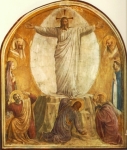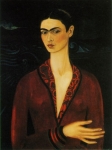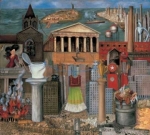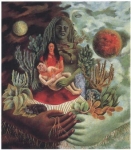Where else but at Calshot Bay, a little known stretch of coast close by Fawley power station in Hampshire, where the great liners still slip out of Southampton Water, dwarfing beach huts to the size of matchboxes, and an annual cricket match takes place on a sandbank two miles out to sea?
William and I motored down last weekend and spent a pleasant few hours re-acquainting ourselves with the pleasures of this gloriously eccentric place. I was promised a fishing trip by an amiable ruddy-faced 'sea dog' from Farnborough and we swam with a man whose boyfriend of ten years was wanted by the Police in Reading and 'of NFA - no fixed abode'. The fisherman had bought his beach hut from the wife of the film director Ken Russell, whose family own a line of the grander huts at the west end of the beach.
 Calshot Spit was home to Lawrence of Arabia, when he was stationed at the RAF base there. Here is a castle built in 1540 to defend Southampton Harbour, which was even then one of the largest ports in the land. The last ever Schneider Cup flying boat races were held here and a giant Grade II* listed hangar from 1917 is named after the Sopwith Camel, said to be one of the finest fighter planes of the First World War. Cyclists now race where the aircraft stood as the hangars house an echoing velodrome that is part of the Calshot Activities Centre.
Calshot Spit was home to Lawrence of Arabia, when he was stationed at the RAF base there. Here is a castle built in 1540 to defend Southampton Harbour, which was even then one of the largest ports in the land. The last ever Schneider Cup flying boat races were held here and a giant Grade II* listed hangar from 1917 is named after the Sopwith Camel, said to be one of the finest fighter planes of the First World War. Cyclists now race where the aircraft stood as the hangars house an echoing velodrome that is part of the Calshot Activities Centre.
 We chatted in the Bluebird - Calshot's tiny beach café, named after a Schneider craft - watching the confusion of boats moored around a cricket match being played on the Brambles sand bar two miles out in the Solent. This truly bizarre institution takes place for only about an hour on just one day a year. There is (barely) enough dry land for players from two sailing clubs on the Isle of Wight and at Southampton to take their runs against a backdrop of supertankers.
We chatted in the Bluebird - Calshot's tiny beach café, named after a Schneider craft - watching the confusion of boats moored around a cricket match being played on the Brambles sand bar two miles out in the Solent. This truly bizarre institution takes place for only about an hour on just one day a year. There is (barely) enough dry land for players from two sailing clubs on the Isle of Wight and at Southampton to take their runs against a backdrop of supertankers.
Earlier we had been politely asked to leave a stretch of protected beach by two well-spoken fellows in cream chinos and blue Oxford shirts - summer uniform of the young upper class male - one of whom (I think) turned out to be a scion of the Drummond family, who made their money as royal bankers. The family own the Cadland Estate. Just before I had chatted to an estate worker with a pleasant Hampshire burr who said he was down on the beach to check out the fishing.
 The water was pleasantly warm and shallow as William and I swam together from the far end of the beach to the steps of Luttrell's Tower, a splendid 18th century folly now owned by the Landmark Trust. On the drive home the sun set spectacularly behind power pylons, but all my thoughts were of the glories of the English seaside.
The water was pleasantly warm and shallow as William and I swam together from the far end of the beach to the steps of Luttrell's Tower, a splendid 18th century folly now owned by the Landmark Trust. On the drive home the sun set spectacularly behind power pylons, but all my thoughts were of the glories of the English seaside.
-
-
Transfigured in St Paul's?
 To St Paul's in London for a Saturday service on the Feast of the Transfiguration. Friends from Schola Aquae Sulis sang music by Howells and the sermon asked for prayers 'for this beautiful but broken world' on the 60th anniversary of the bombing of Hiroshima.
To St Paul's in London for a Saturday service on the Feast of the Transfiguration. Friends from Schola Aquae Sulis sang music by Howells and the sermon asked for prayers 'for this beautiful but broken world' on the 60th anniversary of the bombing of Hiroshima.
Transfiguration - when Christ's clothes became dazzling white and a voice said 'this is my Son, listen to Him' was the theme, with a parallel with moments of transfiguration in our own lives.
The sermon quoted research documenting instances of theophany: moments when the divine is suddenly made visible. In landscape, when the light changes and everything seems for an instant transformed, at peace and whole – I have experienced these feelings.
Were there moments like these in the service, when incense mixed with incantatory chants, and light shone on a distant cross on the high altar, music wove a spell and the great cathedral became much more than a glitteringly grandiose tourist attraction?
Music has this power to move and transform me. It was like this in a late night Prom in the Royal Albert Hall last Thursday. The Canadian counter tenor Daniel Taylor sang the Handel aria 'Cara sposa, amante cara' from Rinaldo. The piteous, plaintive threads of music seemed to shape filigree patterns in the air around us, drawing together audience and performer in a moment of great stillness and beauty.
But are these 'feelings' real - whatever that means? They might not withstand scientific examination, but it seems to me that there is a transforming power in these humbling moments of transfiguration that can inform our whole lives.
Tentatively I pray this hope can endure amid all our cruelty and greed and selfishness. -
Kahlo at the Tate
 For André Breton 'the art of Frida Kahlo is a ribbon about a bomb'. A major exhibition at the Tate Modern (to 9 October, 2005) features her powerful work. Many have been gripped by the fascination of Frida Kahlo: not because it is intensely beautiful or hugely grand but because it is deeply personal, intensely vivid and raw. Red raw even with her own blood and with her own tears that fall in self-portraits where her body - maimed by a violent accident that cast its shadow across her life - lies ripped open. Her beautiful face lingers most in the memory. Her expression is proud, resigned and defiant. She is vulnerable and yet composed, face half-turned away from her viewer.
For André Breton 'the art of Frida Kahlo is a ribbon about a bomb'. A major exhibition at the Tate Modern (to 9 October, 2005) features her powerful work. Many have been gripped by the fascination of Frida Kahlo: not because it is intensely beautiful or hugely grand but because it is deeply personal, intensely vivid and raw. Red raw even with her own blood and with her own tears that fall in self-portraits where her body - maimed by a violent accident that cast its shadow across her life - lies ripped open. Her beautiful face lingers most in the memory. Her expression is proud, resigned and defiant. She is vulnerable and yet composed, face half-turned away from her viewer.
In her marriage to the muralist Diego Rivera she found the basis for an enduring connection with the Mexican soil and its ancient people. Mexican pitahaya fruit plump erotically and are pierced by needle sharp flags like the steel that shattered her spine and took away her womb.
 There is duality in her attempt to square her European father with her campesina mother: stiff colonial dresses are juxtaposed with the peasant costume that was her trademark. Duality in her bisexuality too, and in My Dress Hangs There, 1933 which illustrates her antithesis to American 'Fordism' with its concrete factories and obsession with sport and hygiene. Her sense that she sprang from the Mexican soil and that she would return to it gave her hope of a kind of reincarnation. This powerful spirituality, which fused east and west and placed both Gandhi and Hitler in her pantheon, provided an enduring message of hope, carved out of Kahlo's despair and desperate adversity.
There is duality in her attempt to square her European father with her campesina mother: stiff colonial dresses are juxtaposed with the peasant costume that was her trademark. Duality in her bisexuality too, and in My Dress Hangs There, 1933 which illustrates her antithesis to American 'Fordism' with its concrete factories and obsession with sport and hygiene. Her sense that she sprang from the Mexican soil and that she would return to it gave her hope of a kind of reincarnation. This powerful spirituality, which fused east and west and placed both Gandhi and Hitler in her pantheon, provided an enduring message of hope, carved out of Kahlo's despair and desperate adversity.
 The cosmology of the Love-Embrace of the Universe (1949), in which she cradles Diego as naked adult foetus while she too is cradled by the Mexican earth goddess who in turn is wrapped by a female sun and moon, seemed a most poignant encapsulation of her spiritual journey.
The cosmology of the Love-Embrace of the Universe (1949), in which she cradles Diego as naked adult foetus while she too is cradled by the Mexican earth goddess who in turn is wrapped by a female sun and moon, seemed a most poignant encapsulation of her spiritual journey.As the light faded that afternoon I swam great circles in the men's pond on Hampstead Heath. Trees hid the broad pond from London and the water was sweet with an earthy murkiness.